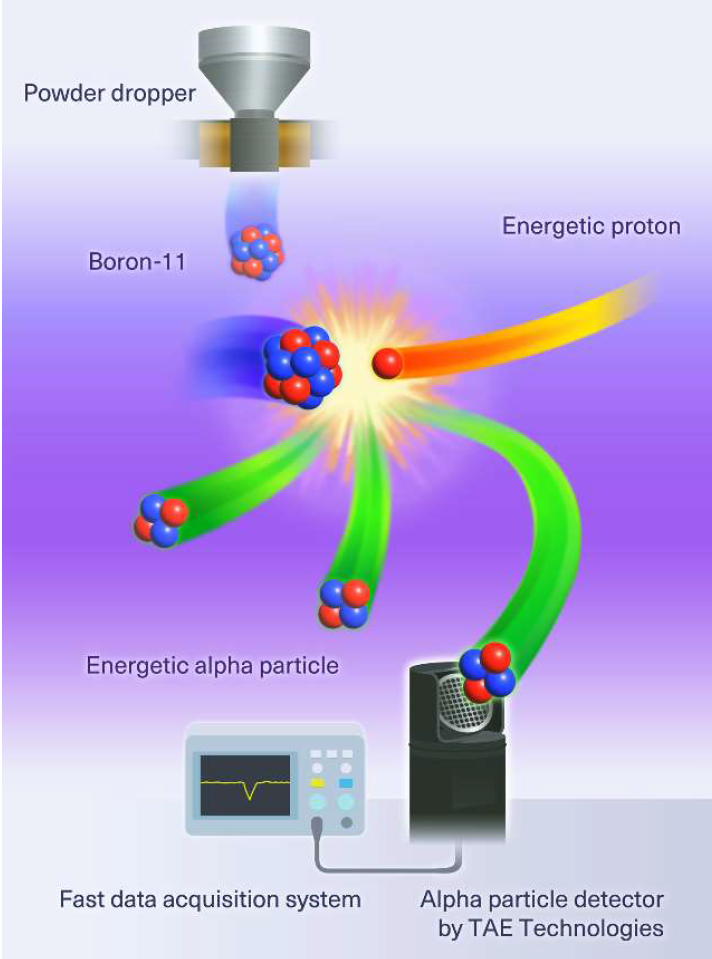Demonstration of fusion reactions using advanced fusion fuels
- A first step toward a clean fusion reactor using a hydrogen-boron reaction that does not produce neutrons -
Results of joint research with TAE Technologies
2023.3.9
Research Results (Press Release)
Summary
The National Institute for Fusion Science and TAE Technologies research group has demonstrated the world's first fusion reaction between hydrogen and boron-11 in a magnetic confinement fusion plasma, using the Large Helical Device. The proton and boron-11 reaction to produce alpha particles does not produce neutrons. Hydrogen and boron-11 are regarded as advanced fusion fuels because they enable the concept of cleaner fusion reactors. The results of this work are a major first step towards the realization of fusion reactors using advanced fusion fuels.
Research Background
 Boron was injected into the plasma using a powder dropper, and energetic hydrogen ions were also injected. The proton and boron-11 reaction produced three energetic helium ions, some of which reached the alpha particle detector. The signal was recorded by a highspeed waveform recorder.
Boron was injected into the plasma using a powder dropper, and energetic hydrogen ions were also injected. The proton and boron-11 reaction produced three energetic helium ions, some of which reached the alpha particle detector. The signal was recorded by a highspeed waveform recorder.Fusion reactors are expected to be a promising energy source that does not produce greenhouse gases in a future sustainable society. Their fuels are deuterium and tritium, but in recent years, research toward cleaner fusion reactors has been active, especially among venture capital companies from around the world. Cleaner fusion reactors will use advanced fusion fuels, which are more difficult to fuse than deuterium and tritium ones, but do not produce neutrons. On 1 September 2021, the NIFS signed an agreement with TAE Technologies, one of the oldest fusion start-up companies in the United States of America, to start joint research using the advanced fusion fuels, hydrogen and boron-11. Until now, no proton and boron-11 fusion reactions have been demonstrated in magnetic confinement devices. If such a reaction can be demonstrated in the LHD, this would be a major step forward in research toward the realization of a fusion reactor using advanced fusion fuels.
A research group led by Associate Professor Kunihiro Ogawa and Professor Satoru Ohdachi, in collaboration with TAE Technologies, has demonstrated a fusion reaction between proton and boron-11 in the LHD. A thermal fusion reactor using hydrogen and boron-11 fuel is considered to be difficult to create because an extremely-high-temperature plasma is required, compared to deuterium and tritium fuels. However, a hydrogen and boron-11 reactor is possible using energetic hydrogen beams, and the research for this has been led by TAE Technologies. To efficiently cause a fusion reaction, the protons must collide with boron-11 at a speed of more than 15,000,000 km/h. The LHD is equipped with the world's only operational hydrogen beam injectors that can force hydrogen into plasma at speeds exceeding 15,000,000 km/h and a powder dropper that can also inject boron into it. These enable fusion reactions between protons and boron11 in a magnetically confined plasma.
Significance of results
A fusion reaction between protons and boron-11 produces energetic helium. To demonstrate the reaction, the energetic helium must be detected. For this purpose, the research group predicted the number of helium particles produced and their trajectories, based on numerical simulations, validated in LHD experiments. An alpha particle detector based on a large area semiconductor detector built by TAE Technologies was placed near the surface of the plasma where the energetic helium was predicted to come. As a result of an experiment in which an energetic hydrogen beam was injected into the boron-sprinkled plasma, energetic helium produced by the fusion reaction between protons and boron11 was successfully detected, as predicted. This was the world's first demonstration of a fusion reaction between protons and boron-11 in a magnetic confinement fusion plasma. The results of this research are a major first step toward the realization of a cleaner magnetic confinement fusion reactor, using advanced fusion fuels. In the future, we intend to proceed with research on the energy dependence and space distribution of the proton and boron-11 reaction, as well as the energy distribution of energetic helium, in order to better understand the fusion reaction between protons and boron-11.
This research result was published in Nature Communications, the world's premier scientific journal, on 21 February 2023.
Paper information
R. M. Magee, K. Ogawa et al., “First measurements of p11B fusion in a magnetically confined plasma”, Nature Communications, 14 (2023) 955.
